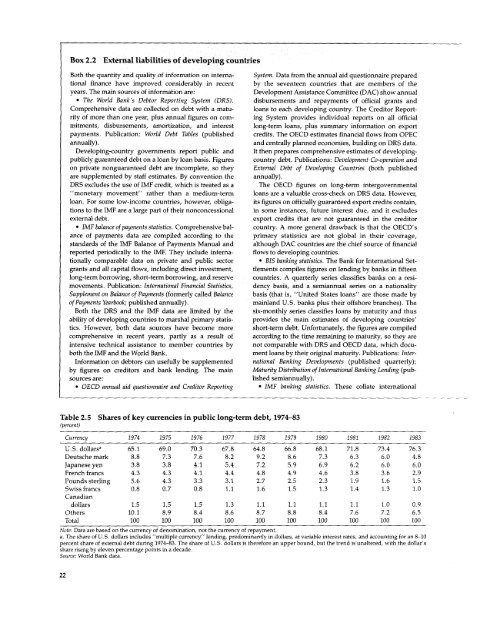World Bank Document
World Bank Document
World Bank Document
You also want an ePaper? Increase the reach of your titles
YUMPU automatically turns print PDFs into web optimized ePapers that Google loves.
Box 2.2 External liabilities of developing countries<br />
Both the quantity and quality of information on interna- System. Data from the annual aid questionnaire prepared<br />
tional finance have improved considerably in recent by the seventeen countries that are members of the<br />
years. The main sources of information are:<br />
Development Assistance Committee (DAC) show annual<br />
* The <strong>World</strong> <strong>Bank</strong>'s Debtor Reporting System (DRS). disbursements and repayments of official grants and<br />
Comprehensive data are collected on debt with a matu- loans to each developing country. The Creditor Reportrity<br />
of more than one year, plus annual figures on com- ing System provides individual reports on all official<br />
mitments, disbursements, amortization, and interest long-term loans, plus summary information on export<br />
payments. Publication: <strong>World</strong> Debt Tables (published credits. The OECD estimates financial flows from OPEC<br />
annually).<br />
and centrally planned economies, building on DRS data.<br />
Developing-country governments report public and It then prepares comprehensive estimates of developingpublicly<br />
guaranteed debt on a loan by loan basis. Figures country debt. Publications: Development Co-operation and<br />
on private nonguaranteed debt are incomplete, so they External Debt of Developing Countries (both published<br />
are supplemented by staff estimates. By convention the annually).<br />
DRS excludes the use of IMF credit, which is treated as a The OECD figures on long-term intergovernmental<br />
"monetary movement" rather than a medium-term loans are a valuable cross-check on DRS data. However,<br />
loan. For some low-income countries, however, obliga- its figures on officially guaranteed export credits contain,<br />
tions to the IMF are a large part of their nonconcessional in some instances, future interest due, and it excludes<br />
external debt. export credits that are not guaranteed in the creditor<br />
* IMF balance of payments statistics. Comprehensive bal- country. A more general drawback is that the OECD's<br />
ance of payments data are compiled according to the primary statistics are not global in their coverage,<br />
standards of the IMF Balance of Payments Manual and although DAC countries are the chief source of financial<br />
reported periodically to the IMF. They include interna- flows to developing countries.<br />
tionally comparable data on private and public sector * BiS banking statistics. The <strong>Bank</strong> for International Setgrants<br />
and all capital flows, including direct investment, tlements compiles figures on lending by banks in fifteen<br />
long-term borrowing, short-term borrowing, and reserve countries. A quarterly series classifies banks on a resimovements.<br />
Publication: International Financial Statistics, dency basis, and a semiannual series on a nationality<br />
Supplement on Balance of Payments (formerly called Balance basis (that is, "United States loans" are those made by<br />
of Payments Yearbook; published annually).<br />
mainland U.S. banks plus their offshore branches). The<br />
Both the DRS and the IMF data are limited by the six-monthly series classifies loans by maturity and thus<br />
ability of developing countries to marshal primary statis- provides the main estimates of developing countries'<br />
tics. However, both data sources have become more short-term debt. Unfortunately, the figures are compiled<br />
comprehensive in recent years, partly as a result of according to the time remaining to maturity, so they are<br />
intensive technical assistance to member countries by not comparable with DRS and OECD data, which docuboth<br />
the IMF and the <strong>World</strong> <strong>Bank</strong>.<br />
ment loans by their original maturity. Publications: Inter-<br />
Information on debtors can usefully be supplemented national <strong>Bank</strong>ing Developments (published quarterly);<br />
by figures on creditors and bank lending. The main Maturity Distribution of International <strong>Bank</strong>ing Lending (pubsources<br />
are:<br />
lished semiannually).<br />
* OECD annual aid questionnaire and Creditor Reporting * IMF banking statistics. These collate international<br />
Table 2.5 Shares of key currencies in public long-term debt, 1974-83<br />
(percent)<br />
Currency 1974 1975 1976 1977 1978 1979 1980 1981 1982 1983<br />
U.S. dollarsa 65.1 69.0 70.3 67.8 64.8 66.8 68.1 71.8 73.4 76.3<br />
Deutsche mark 8.8 7.3 7.6 8.2 9.2 8.6 7.3 6.3 6.0 4.8<br />
Japanese yen 3.8 3.8 4.1 5.4 7.2 5.9 6.9 6.2 6.0 6.0<br />
French francs 4.3 4.3 4.1 4.4 4.8 4.9 4.6 3.8 3.6 2.9<br />
Pounds sterling 5.6 4.3 3.3 3.1 2.7 2.5 2.3 1.9 1.6 1.5<br />
Swiss francs 0.8 0.7 0.8 1.1 1.6 1.5 1.3 1.4 1.3 1.0<br />
Canadian<br />
dollars 1.5 1.5 1.5 1.3 1.1 1.1 1.1 1.1 1.0 0.9.<br />
Others 10.1 8.9 8.4 8.6 8.7 8.8 8.4 7.6 7.2 6.5<br />
Total 100 100 100 100 100 100 100 100 100 100<br />
Note: Data are based on the currency of denomination, not the currency of repayment.<br />
a. The share of U.S. dollars includes "multiple currency" lending, predominantly in dollars, at variable interest rates, and accounting for an 8-10<br />
percent share of external debt during 1974-83. The share of U.S. dollars is therefore an upper bound, but the trend is unaltered, with the dollar's<br />
share rising by eleven percentage points in a decade.<br />
Source: <strong>World</strong> <strong>Bank</strong> data.<br />
22

















